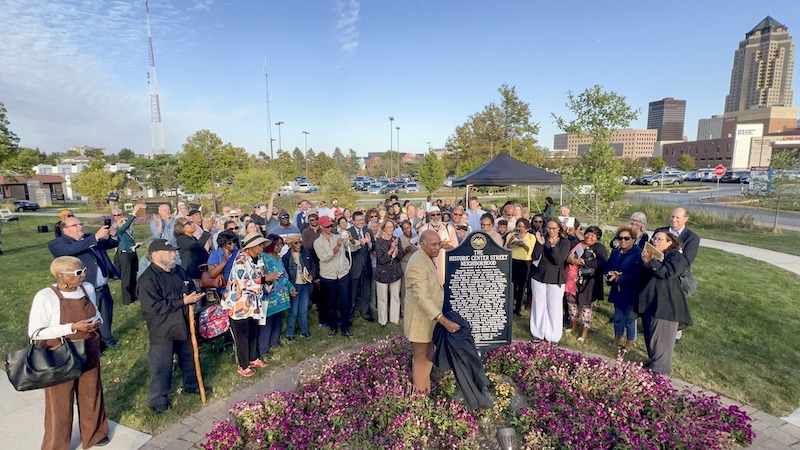
Jan/Feb 2024 (Volume 16, Issue 1)
By Michael Swanger
Signs of our beloved state’s history abound while driving across Iowa, so much so that you might take them for granted. Whether it is the name of an honorary street, a county marker, or a museum’s advertising billboard planted in a farmer’s field near the highway, they deserve more than just a passing glance as you drive by them. They deserve your curiosity and time.
No entity, perhaps, understands the importance of such roadside reminders of Iowa’s history more so than the State Historical Society of Iowa (SHSI) whose historical markers “raise awareness of Iowa’s rich cultural history and connect people to the places and points of pride that make the state unique.”

The State Historical Society of Iowa’s historical marker that recognizes the Historic Center Street Neighborhood was unveiled last fall. It is located in Center Street Park near the entrance of UnityPoint Health’s parking lot south of Center Street between 12th and 15th streets in Des Moines. Photo courtesy of State Historical Society of Iowa
I was reminded of that last October when visiting the SHSI’s new historical marker that recognizes the Historic Center Street Neighborhood in Des Moines. An unveiling ceremony hosted by the SHSI, Polk County Housing Trust Fund and UnityPoint Health — Des Moines supported the marker’s purpose as former residents and officials gathered to remember the neighborhood.
Center Street was a vibrant business and cultural hub for the Black community of Des Moines between the early 1900s and late 1960s. Located north of downtown Des Moines, it stretched from 15th Street to Keosauqua Way, and featured a variety of Black-owned grocery stores, hotels, restaurants, jazz clubs and other businesses. The neighborhood was also where its predominantly Black residents owned homes, attended church and welcomed the construction of the Crocker YMCA and Wilkie House, which received a similar historical marker last September.
“You know, some cannot even begin to imagine what this place was,” said local historian and former Center Street resident Richard Duncan, the keynote speaker at the marker’s unveiling on Oct. 5, 2023, in Center Street Park. “You know, some people look and now they can see the Oakridge community. They can hear the traffic on the freeway, I-235. But when I stand here, and I look around, what I see is a displaced community, a displaced business district. I see it as it was. I see it as it used to be.”
Unfortunately, for its residents and businesses, the late 1960s marked the beginning of the end for the Center Street neighborhood. Center Street, like so many other Black neighborhoods across the nation, was demolished during the federal government’s Urban Renewal programs and construction of the nationwide freeway system. The government’s funding to remove “blighted” areas displaced Center Street’s Black residents and businesses and by 1970 — after the newly-built MacVicar Freeway (I-235) had cut the neighborhood in half — the neighborhood that its residents once called “a city within a city” was gone.
The story of Center Street lives in the hearts and minds of the neighborhood’s surviving former residents as well as on the pages of history books. But the marker serves as a touchstone for the broader community to learn about Center Street’s history according to Jay Singleton, who grew up on Center Street and serves on the Polk County Housing Trust Fund’s board of directors.
“There’s a lot of people that don’t understand what happened to Center Street,” Singleton told the crowd. “There’s a lot of African Americans who don’t understand it; there’s a lot of native Iowans who don’t understand that — so I challenge you to tell the story. Don’t let this be one moment.”
The Center Street historical marker is one of 54 erected by the SHSI in 32 counties in Iowa. A map of Iowa’s official historical markers can be found on the SHSI’s website, https://history.iowa.gov/history.
When the weather warms up this spring, and you spontaneously spot one of the SHSI’s historical markers while driving across the state, take a few minutes to visit one and connect with our state’s history.
TO READ MORE FASCINATING STORIES ABOUT IOWA HISTORY, subscribe to Iowa History Journal. You can also purchase back issues at the store.
